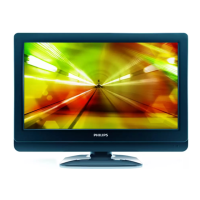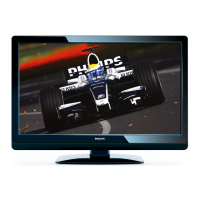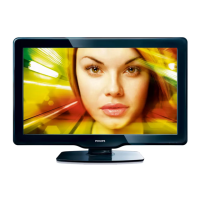Do you have a question about the Philips 32PFL3508 and is the answer not in the manual?
Explains the meaning of safety symbols like lightning flash and exclamation point.
Provides safety advice for children regarding TV placement and use.
A list of 14 numbered safety instructions for operating the TV.
Safety precautions for installing wall mount brackets and TV.
Lists ownership of trademarks and copyright notices.
Explains properties of LCD pixels and potential display variations.
Details warranty conditions and service center requirements.
Guidance on safely positioning and handling the television unit.
Information regarding compliance and safety standards.
Advice on recycling packaging and proper disposal.
Instructions for disposing of used batteries safely and responsibly.
Lists and explains the TV's various functionalities and capabilities.
Details the items included with the TV package.
Explains the meaning of symbols used in the user manual.
Step-by-step guide for securely attaching the TV's base.
Instructions for inserting batteries into the remote control.
Functions of power, disc playback, and EasyLink buttons.
Buttons for accessing menus and displaying program information.
Controls for channel selection, volume adjustment, and picture format.
Buttons for Mute, Sleep Timer, and Closed Caption.
Explains the purpose of each button on the TV's control panel.
Identifies and describes the various input/output ports on the TV.
Guides on connecting antennas and various set-top boxes.
Instructions and caution for connecting the TV to a power outlet.
Connecting via HDMI for high-definition digital video and audio.
Connecting to devices with DVI terminals using an HDMI-DVI cable.
Connecting using Component Video cables for analog signals.
Connecting using composite video cables for basic quality.
Instructions for connecting Component Video and analog audio.
How to connect digital audio devices using a coaxial cable.
Details connecting Composite Video and analog audio.
Connecting the TV to a PC via HDMI, DVI, or VGA.
How to use a USB Memory Stick for viewing photos and videos.
Configures TV for home or retail use, affecting settings and display.
Guides through customizing picture settings using test images.
Instructions for turning the TV on from standby and putting it into standby.
How to increase, decrease, or mute the TV volume.
Methods for selecting channels using buttons or number input.
Switching between TV sources and external devices.
Selecting different audio modes like Stereo, Mono, or SAP.
Programming the TV to turn off automatically after a set time.
Operating linked devices using the TV remote via HDMI CEC.
Adjusting the TV screen aspect ratio for different video signals.
Shows detailed info like program title, rating, and audio language for digital channels.
Displays channel number, audio mode, and aspect ratio for analog signals.
How to display and navigate the main menu structure.
Guides through customizing picture settings using test images.
Fine-tuning color, brightness, contrast, and other visual parameters.
Adjusting sound settings like Auto sound, Equalizer, and volume leveling.
Automatically scans and memorizes available TV channels.
Viewing, skipping, or reactivating channels.
Manually add off-air analog channels not found by autoprogram.
Checks and displays the digital signal strength for each channel.
Adjusts display of closed captions, including text size, font, and color.
Setting PIN codes and blocking programs based on age ratings.
Hides specific channels or input modes from selection.
Locks movies based on MPAA rating system.
Locks TV programs based on age and content ratings.
Sets program viewing restrictions based on Canadian rating systems.
Optimizes PC input screen position, clock, and phase.
Allows users to set or change their personal identification number.
View and control connected EasyLink devices via HDMI CEC.
Configures TV for home or retail use, affecting settings and display.
Chooses the on-screen display language for the TV menus.
Manages the display of the electronic sticker on the TV screen.
Displays JPEG image files from a USB Memory Stick.
Details playing Motion JPEG video files, including controls and file info.
Instructions for downloading the latest software upgrade file from the website.
How to view the TV's currently installed software version.
Step-by-step guide for upgrading the TV software using a USB stick.
Answers common user questions regarding remote control, setup, and picture/caption issues.
Solutions for issues related to power supply and remote control functionality.
Tips for resolving problems with image quality and audio output.
Troubleshooting steps for screen display anomalies and caption issues.
Definitions of technical terms and standards used in the manual.
Guidance on cleaning the unit and when to seek professional service.
How to test the remote control's infrared signal using a camera.
Details screen size, aspect ratio, tuner type, and audio output.
Lists picture formats, video playback, channel coverage, and tuning system.
Specifies input/output ports, power requirements, and operating temperature.
| 3D | No |
|---|---|
| Power | 52 W |
| Display resolution (numeric) | 1366 pixels |
| Weight (with stand) (imperial) | 13.12 lbs |
| Dimensions (W x D x H) (imperial) | 29.70 x 4.20 x 18.40 \ |
| Screen shape | Flat |
| Response time | 8 ms |
| Display diagonal | 32 \ |
| Display brightness | 250 cd/m² |
| Display resolution | 1366 x 768 pixels |
| Native aspect ratio | 16:9 |
| LED backlighting type | - |
| Supported video modes | 480i |
| Contrast ratio (typical) | 1200:1 |
| Display diagonal (metric) | 81.28 cm |
| Screen format adjustments | 4:3, 16:9, Zoom |
| Supported graphics resolutions | 1024 x 768 (XGA), 1280 x 768 (WXGA), 1360 x 768 (WXGA), 640 x 480 (VGA), 800 x 600 (SVGA) |
| Supported TV bands | UHF, VHF |
| Analog signal format system | NTSC |
| Digital signal format system | ATSC |
| Audio decoders | Dolby Digital, DTS, Dolby Digital AC3, DTS TruSurround |
| RMS rated power | 2 W |
| Number of speakers | 2 |
| Equalizer bands quantity | 5 |
| HDMI ports quantity | 3 |
| DVI-D ports quantity | 0 |
| USB 2.0 ports quantity | 1 |
| Consumer Electronics Control (CEC) | EasyLink |
| Product color | Black |
| Panel mounting interface | 200 x 100 mm |
| AC input voltage | 120 V |
| AC input frequency | 50 - 60 Hz |
| Power consumption (standby) | 0.5 W |
| Package depth | 162.56 mm |
| Package width | 843.28 mm |
| Package height | 563.88 mm |
| Package weight | 7801.8 g |
| Sustainability certificates | ENERGY STAR |
| Operating temperature (T-T) | 5 - 40 °C |
| Depth (with stand) | 180.34 mm |
|---|---|
| Height (with stand) | 515.62 mm |
| Weight (with stand) | 5951 g |
| Depth (without stand) | 106.68 mm |
| Width (without stand) | 754.38 mm |
| Height (without stand) | 467.36 mm |
| Weight (without stand) | 5601.9 g |












